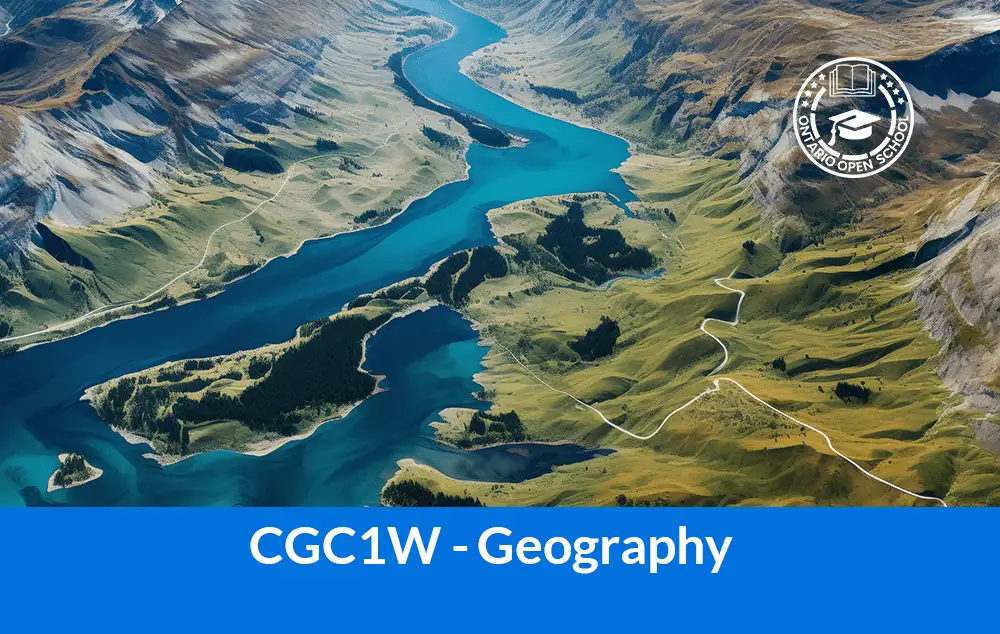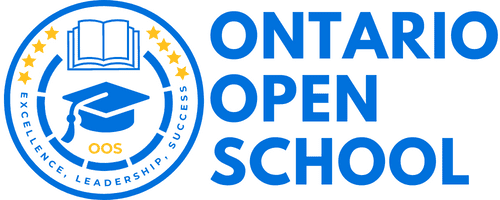- info@ontarioopenschool.com
- 647-494-4499
-
Unit 100 - 29 Gervais Drive, North York, ON.
M3C 1Y9
Copyright 2024 Ontario Open School Inc. All Rights Reserved.
This course examines interrelationships within and between Canada’s natural and human systems and how these systems interconnect with those in other parts of the world. Students will explore environmental, economic, and social geographic issues relating to topics such as transportation options, energy choices, and urban development. Students will apply the concepts of geographic thinking and the geographic inquiry process, including spatial technologies, to investigate various geographic issues and to develop possible approaches for making Canada a more sustainable place in which to live.
Unit Order | Unit Name | Suggested Time |
|---|---|---|
| Unit 1 | Introduction: Exploring Geography | 10 hours |
| Unit 2 | Interactions with the Physical Environment | 22 hours |
| Unit 3 | Resources and Industries | 30 hours |
| Unit 4 | Changing Populations | 18 hours |
| Unit 5 | Livable Communities | 20 hours |
| Final Evaluation 30% | Final Culminating Project For their final project, students apply course concepts to analyzing a global issue collaboratively with a partner. They will apply their research skills and consult a variety of media and literature to substantiate their claims. They will create a final media piece to present their findings (documentary, video presentation, PowerPoint, Prezi, etc.) Final Exam | 8 hours 2 hours |
| Total | 110 Hours |
A variety of strategies are used to allow students many opportunities to attain the necessary skills for success in this course. The teacher uses a variety of whole class, small group and individual activities to facilitate learning. The following is a list of specific teaching/learning strategies that the teacher may use but is not limited to:
|
Course Specific |
Language |
Collaborative |
|
Direct teaching Teaching notes Work and tasks sheets Homework Independent reading Independent study Problem solving Information Analysis Research Portfolio Reflection Presentation Decision making Group Assignments Brainstorming Diagrams Problem-based learning Peer-evaluation Self-evaluation |
Oral presentation Class Discussion Small group discussion Teacher-student conferencing Peer-evaluation Personal response notes Reading and answering questions Socratic Dialogue |
Cooperative learning Peer-evaluation Brainstorming Group discussion Student-teacher conferencing |
Purpose
The primary purpose of assessment is to improve student learning. Assessment relates directly to the expectations for the course.
A variety of assessments for and as learning are conducted on a regular basis to allow ample opportunities for students to improve and ultimately demonstrate their full range of learning and for the teacher to gather information to provide feedback. Assessment tasks relate to the success criteria set out in lesson plans. Success criteria allow students to see what quality looks like.
Evaluation is the process of judging the quality of student work in relation to the achievement chart categories and criteria and assigning a percentage grade to represent that quality. Evaluation is based on gathering evidence of student achievement through:
Assessment for Learning – we provide feedback and coaching. Assessment FOR Learning is the process of seeking and interpreting evidence for the use of learners and their teachers to decide where the learners are in their learning, where they need to go, and how best to go there.
Assessment as Learning – we help students monitor progress, set goals, reflect on their learning
Assessment AS Learning is the process of the explicit fostering of students’ capacity over time to be their own best assessors, but teachers need to start by presenting and modeling external, structured opportunities for students to assess themselves.
Assessment of Learning – we use assessments to provide evaluative statements about student achievement. Assessment OF Learning is the assessment that becomes public and results in statements of symbols
(marks/grades/levels of achievement) about how well students are learning. It often contributes to pivotal decisions that will affect students’ future.
ASSESSMENT TOOLS
| Assessment tools marked with “x” are used in the course. | |||
| Marking schemes | X | Rubrics | X |
| Anecdotal comments | X | Checklists | X |
| Rating Scales | |||
Assessment/ Evaluation Strategies
| Assessment for Learning | Assessment as Learning | Assessment of Learning | |||
| Quizzes | Journal/Reflections | X | Tests | X | |
| Tests | Exit and Entrance Cards | Presentations | X | ||
| Presentations | KWL Chart | Journals | |||
| Journals | X | Self/Peer assessment | X | Essays | |
| Essays | Logs | Models | |||
| Models | Projects | X | |||
| Projects | X | Demonstrations | |||
| Demonstrations | X | Conferencing | |||
| Conferencing | X | Questioning | X | ||
| Questioning | X | Independent Study Assignment | X | ||
| Independent Study Assignment | Art Exhibits | ||||
| Art Exhibits | Researching | X | |||
| Researching | X | Reading Aloud | |||
| Reading Aloud | Problem Solving (process focused) | ||||
| Problem Solving (process focused) | X | Debates | |||
| Debates | Work Sheets | ||||
| Work Sheets | X | Role Playing | |||
| Role Playing | Direct Instruction | ||||
| Direct Instruction | X | ||||
Resources
Growing Success: Assessment, Evaluation and Reporting in Ontario Schools (2010)
http://www.edu.gov.on.ca/eng/policyfunding/growSuccess.pdf
Clark, Bruce; Wallace, John K., and Earle, Kim M. Making Connections: Canada’s Geography (Second Edition). Pearson Education Canada, Toronto, 2006.
Grading:
The final grade is based on performance in 3 areas: products, observations, conversations.
Weighting of categories
| Knowledge/Understanding | Thinking/Inquiry | Communication | Application |
| 25% | 25% | 25% | 25% |
Planning for the Final Grade:
| 70% Course Evaluation | 30% End-of-Course Evaluation | ||
| The following components will be used to base 70% of each student’s final grade. | The following components will be administered near the end of the course and account for 30% of the final grade. | ||
| Component | Approximate Weighting | Component | Approximate Weighting |
| Unit 1 – Infographic | 6% | Exam | 15% |
| Unit 1 – Research Report | 8% | ISP | 15% |
| Unit 2 – Advertisement/Poster | 6% | ||
| Unit 2 – Unit Test | 9% | ||
| Unit 3 – Journal Response | 7% | ||
| Unit 3 – Debate | 9% | ||
| Unit 4 – Opinion Piece | 7% | ||
| Unit 4 – Political Cartoon | 8% | ||
| Unit Discussions | 10% | ||
| Course Evaluation | 70% | End-of- Course | 30% |
| TOTAL: 100% | |||

Course Grade | Grade 9 |
|---|---|
Course Code | CGC1W |
Course Category | Canadian And World Study |
Course Type | De-Streamed |
Course Delivery | Online |
Course Duration | 110h |
Course Credit | 1.00 |
Copyright 2024 Ontario Open School Inc. All Rights Reserved.
